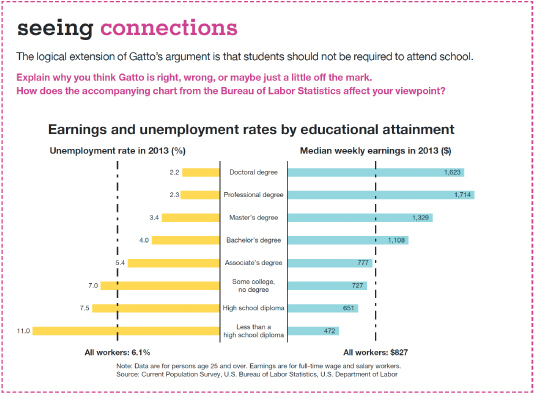100.6
INSIDE THE THEMATIC READINGS CHAPTERS (Chs. 5–
Because we believe that big ideas are the heart and soul of every good English class, this portion of Advanced Language & Literature has been organized thematically to encourage students to ponder enduring questions, tackle cultural issues, and engage in current debates. This groundbreaking thematic anthology weds fiction with nonfiction, poetry with prose, and classic with global literary voices. The result draws students into the vibrant cultural conversations going on in the world around them.
Thematic Chapter Overview
Each thematic chapter shares the following key elements:

Readings — A Blend of Fresh and Familiar Selections
The drama, poetry, fiction, nonfiction, and visual texts in Advanced Language & Literature were designed to be both familiar and fresh, building on classic texts by Shakespeare and Martin Luther King Jr., but then departing from the usual fare by offering literature by authors from around the world such as Chimamanda Ngozi Adichie and Wisława Szymborska, as well as a wealth of new nonfiction voices.
The texts in Advanced Language & Literature range from the approachable to the challenging, and everything in between, to give students of various skill levels points of entry and opportunities to join the conversation.
Reading and Writing Workshops — Opportunities to Deepen Student Skills
Every thematic chapter ends with a Reading Workshop and a Writing Workshop. These brief skill-
Each Reading Workshop begins with a quick skills refresher, and then asks students to work through analysis tasks using brief selections from readings in the chapter.
Each Writing Workshop takes students step-
by- step through the process of writing various types of academic essays.
| READING WORKSHOP | WRITING WORKSHOP | |
| 5 | Analyzing Point of View | Writing a Personal Narrative |
| 6 | Analyzing Figurative Language | Writing an Argument |
| 7 | Argument by Analogy | Using Sources to Write a Synthesis Argument |
| 8 | Analyzing Character and Theme | Writing an Interpretation of Character and Theme |
| 9 | Understanding Irony | Writing a Close Analysis of Prose |
| 10 | Analyzing Diction and Tone | Writing a Rhetorical Analysis |
Key Context — Essential Background for Reading

Many of the readings in Advanced Language & Literature come from times, places, or disciplines that students might not be familiar with. To support these explorations, Advanced Language & Literature provides brief biographies, author images, and special Key Context notes to provide students with information on who is speaking, what the speaker’s background is, and what social or historical context the student needs in order to engage with the text.
Visual Texts — Images with a Purpose


We believe that visual literacy is crucial to being able to understand and analyze our world, and that images in a textbook should not be mere decoration. We made it our goal in Advanced Language & Literature for every visual text to have a clear, authentic pedagogical purpose. Images were carefully selected to inform the reading of a print text, suggest new ideas, provide additional context, extend an understanding to the real world, or allow students to make interesting connections.
Seeing Connections

The Seeing Connections boxes in Advanced Language & Literature give students the opportunity to ponder how the ideas of a piece connect with images, films, and outside texts. These boxes are departures from the text that ask students to explore the world of ideas and find new insights.
Probing Questions — Targeted Practice for Key Skills
Throughout the book are guided questions designed to support and challenge students as they engage with the texts.
| QUESTIONS AFTER A READING | |
| Understanding and Interpreting | Laying the foundation for analysis, these questions guide students to an understanding of the content and move them toward an interpretation. |
| Analyzing Language, Style, and Structure | These questions ask students to look at craft— |
| Connecting, Arguing, and Extending | These writing prompts ask students to connect with the ideas of the text personally (connecting), respond to the issues in the text directly (arguing), or explore the ideas brought up by the text in the world as a whole (extending). |
| Topics for Composing | Found only after Central Texts, these extended essay and project ideas range from narrative and argumentative to research, creative writing, and even multimedia projects. |
| QUESTIONS AFTER A CONVERSATION SECTION | |
| Making Connections | By asking students to compare and contrast two texts in a Conversation, these questions lay the foundation for synthesis. |
| Synthesizing Sources | These are writing prompts that require the use of multiple sources to create original arguments and sometimes call for outside research. |